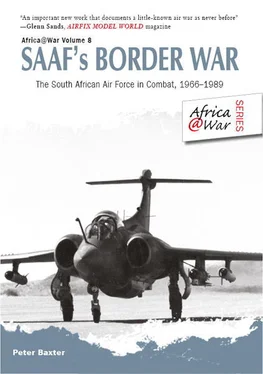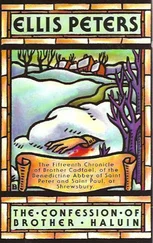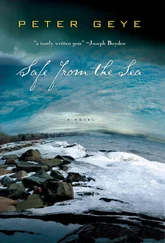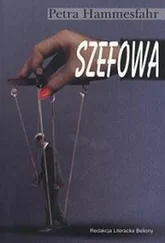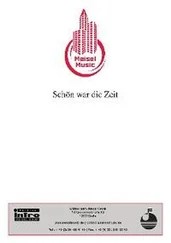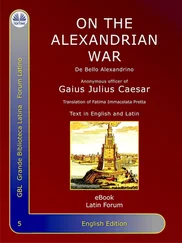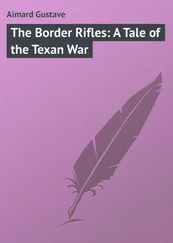Peter Baxter - SAAF's Border War
Здесь есть возможность читать онлайн «Peter Baxter - SAAF's Border War» весь текст электронной книги совершенно бесплатно (целиком полную версию без сокращений). В некоторых случаях можно слушать аудио, скачать через торрент в формате fb2 и присутствует краткое содержание. Город: Solihull, Год выпуска: 2013, ISBN: 2013, Издательство: Helion & Company, Жанр: military_history, на английском языке. Описание произведения, (предисловие) а так же отзывы посетителей доступны на портале библиотеки ЛибКат.
- Название:SAAF's Border War
- Автор:
- Издательство:Helion & Company
- Жанр:
- Год:2013
- Город:Solihull
- ISBN:978-1-908916-23-5
- Рейтинг книги:3 / 5. Голосов: 1
-
Избранное:Добавить в избранное
- Отзывы:
-
Ваша оценка:
- 60
- 1
- 2
- 3
- 4
- 5
SAAF's Border War: краткое содержание, описание и аннотация
Предлагаем к чтению аннотацию, описание, краткое содержание или предисловие (зависит от того, что написал сам автор книги «SAAF's Border War»). Если вы не нашли необходимую информацию о книге — напишите в комментариях, мы постараемся отыскать её.
SAAF's Border War — читать онлайн бесплатно полную книгу (весь текст) целиком
Ниже представлен текст книги, разбитый по страницам. Система сохранения места последней прочитанной страницы, позволяет с удобством читать онлайн бесплатно книгу «SAAF's Border War», без необходимости каждый раз заново искать на чём Вы остановились. Поставьте закладку, и сможете в любой момент перейти на страницу, на которой закончили чтение.
Интервал:
Закладка:
TOD – top of descent
top cover – aerial cover; aircraft were considered prestige targets by the SWAPO insurgents. Aircraft are at their most vulnerable when taking off or landing in the vicinity of airfields. At Ondangwa, therefore, an Alouette gunship was airborne for all movements of fixed-wing transport aircraft. The gunship carried out a wide left-hand orbit of the airfield to counter any attempt by guerrillas to fire at the transport aircraft. The concept was also used in combat areas to cover own ground troops or to make-safe landing zones for troop-carrying helicopters in the bush
TOT – time on target
transonic zone – the speed band where the airflow over the aircraft alters from subsonic to supersonic flow, usually between Mach 0.9 to 1.1. As the aircraft transits through this zone, changes to the centre of pressure can affect stability
Typhoon – SWAPO’s elite group of highly trained troops whose specific task was the deep infiltration of South West Africa. Although highly esteemed by SWAPO, they did not achieve any more notable successes than the ordinary cadres; also referred to as Vulcan or Volcano troops
UDF – Union Defence Force (pre-1957)
UNCIP – unconventional interception profile
Unimog – a 2.5-litre 4x4 Mercedes Benz transport vehicle that bore the brunt of bush operations until SWAPO mine-laying hastened the introduction of mine-protected vehicles
UNITA – União Nacional para a Independência Total de Angola , National Union for the Total Independence of Angola
UNTAG – United Nations Transitional Agreement Group
USSR – Union of Soviet Socialist Republics
ZANLA – Zimbabwe African National Liberation Army, ZANU’s military wing
ZANU – Zimbabwe African National Union
ZAPU – Zimbabwe African People’s Union
ZIPRA – Zimbabwe People’s Revolutionary Army, ZAPU’s military wing
MAPS


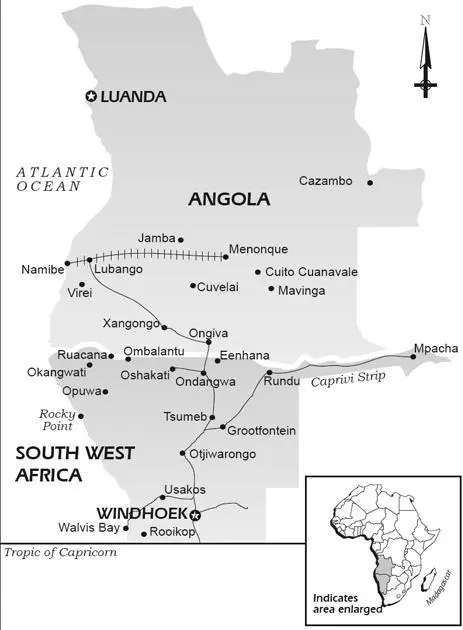
A BRIEF HISTORICAL BACKGROUND
At the end of 1987 and the beginning of 1988 the first conventional tank battle to be fought in Africa since the Second World War and the only one of its kind ever to take place in sub-Saharan Africa was fought over a large expanse of the dense savannah woodland of southern Angola. This was the Battle of Cuito Cuanavale, a series of operations that marked the climax to what has since come to be known as the South African Border War and, moreover, the concluding military chapter of the African Liberation Struggle.
The Battle of Cuito Cuanavale and the slow culmination of events that led up to it, although not specifically related to the South West African war of independence upon which the Border War was largely premised, was a clash of titans that had always been promised once the tide of black liberation – the swart gevaar , or ‘black threat’ – finally reached the borders of South Africa itself. Cuito Cuanavale was more directly a factor of the Angolan civil war, with South Africa acting ostensibly in support of a faction within that conflict, although with the unmistakable strategic objective of securing the border region of South West Africa through this proxy support.
The African liberation period began in the post-Second World War period with the rise of African nationalism, continent-wide, and a concurrent decline of the European appetite for foreign territorial domination. The process, notwithstanding a certain inherent violence, flared into war in key regions where settler minorities sought to resist the inevitable. The most notable of these were Algeria, Kenya, Mozambique, Angola and Rhodesia. The process continued throughout the 1960s, 1970s and 1980s, culminating only in 1994 with the eventual handover of power in Pretoria to a black government voted into office by an authentic majority.

South Africa has always been different from any other territory on the continent of Africa and certainly in sub-Saharan Africa. Militarily and economically, the country hardly occupies the same league as any other nation in the region. With the possible exception of white Rhodesia, the South African Defence Force has been, and remains, unequalled on a per-capita basis by any indigenous military organization anywhere else on the continent.
How and why did South Africa emerge as such a regional superpower? The answer to this is complex and not without a strong hint of the composite race ideology that has been, and perhaps remains, so much a factor in the existence of South Africa as a country. The territory was settled early, with Dutch settlers making landfall in the mid-17th century, and was liberated late. Thus the territory enjoyed a little over 300 years of Europeanization which, whatever might be the current liberation ideology, allowed for the deep entrenchment of western-style civilization and the generation of stable institutions of government over a much longer period than say Kenya or indeed Southern Rhodesia. The latter was removed from the map of Africa in 1980 after a mere 90 years of modern existence.
South Africa has also enjoyed almost unprecedented natural endowments in the form of gold and diamonds which were discovered in the latter half of the 19th century and which at the time were recognized as being the most concentrated deposits in the world. This, needless to say, transformed what had hitherto been a rather lowly and unimportant colonial backwater to arguably the most important theatre of capital adventure and warfare in the entire British Empire. An astonishing amount of wealth began to circulate within the various economies of South Africa, with a great deal more than this finding its way back to various European capital markets, London being perhaps the most important.
No less important were the political ramifications of this transformation. The Cape had been settled by Dutch East India Company men for the purpose of supplying passing vessels en route to the Indies. These had been followed later by waves of Huguenot religious exiles who brought with them the higher cultural sensibilities of their French ancestry. In combination with the Dutch, they evolved a fusion culture that, in the isolation of such an out-of-the-way settlement, developed language, traditions and peculiarities very different from their metropolitan cousins and certainly unlike anything else underway at that time in sub-Saharan Africa. The Portuguese settled the region earlier but tended to apply a lacklustre style of colonialism that saw the evolution of sea ports such as Luanda and Lourenço Marques (Maputo) but little else. The Portuguese always regretted the fact that they failed to occupy the Cape in time to thwart the arrival of other European powers.
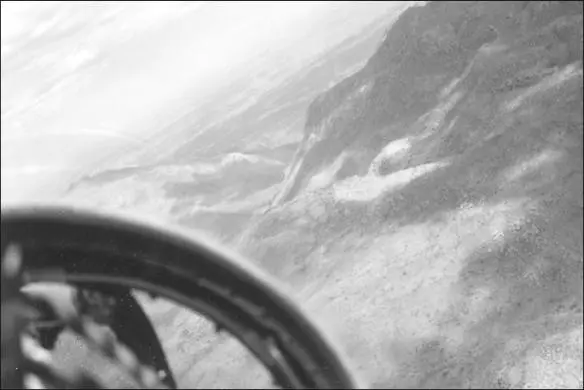
Although highly cultured at their core, the Afrikaner nation, as this new sub-culture identified itself, also comprised a highly parochial outer fringe made up of frontier farmers and herdsmen who spread out over several generations to occupy a significant swath of territory in the hinterland of the Cape. A certain independence of mind also developed among these frontier families who, for much of their early existence, suffered no territorial constraint and certainly had to bear very little interference from any central authority. They developed a highly individualistic, and somewhat backward-looking, cultural identity that had about it a strong strain of ethnocentrism and manifest destiny.
Читать дальшеИнтервал:
Закладка:
Похожие книги на «SAAF's Border War»
Представляем Вашему вниманию похожие книги на «SAAF's Border War» списком для выбора. Мы отобрали схожую по названию и смыслу литературу в надежде предоставить читателям больше вариантов отыскать новые, интересные, ещё непрочитанные произведения.
Обсуждение, отзывы о книге «SAAF's Border War» и просто собственные мнения читателей. Оставьте ваши комментарии, напишите, что Вы думаете о произведении, его смысле или главных героях. Укажите что конкретно понравилось, а что нет, и почему Вы так считаете.
